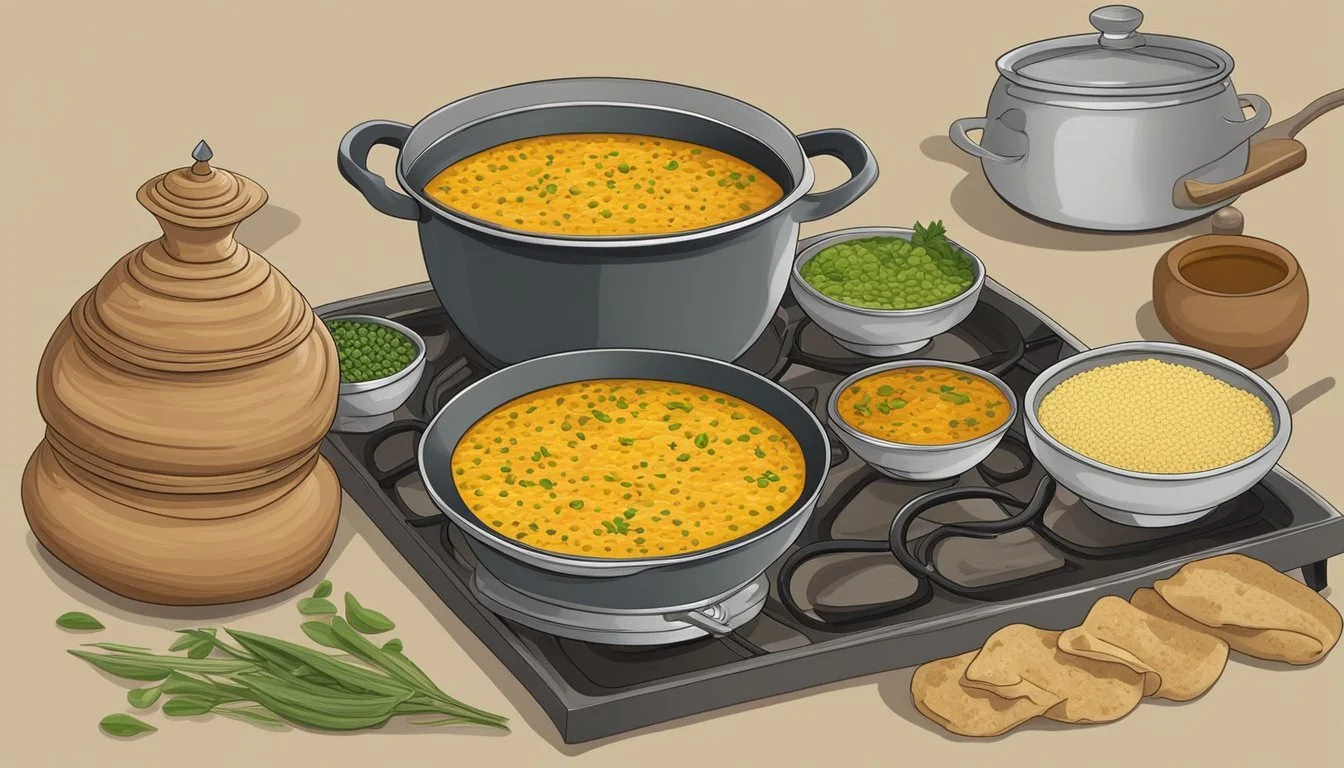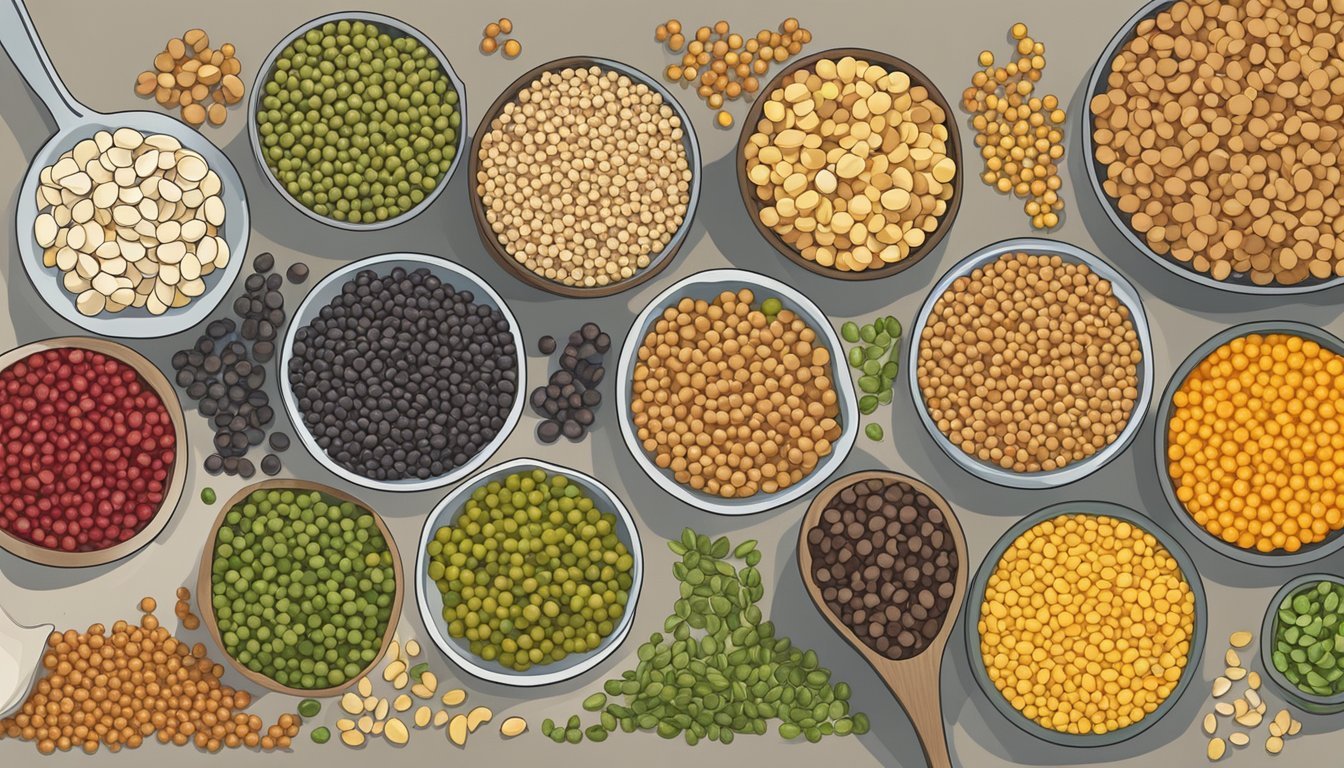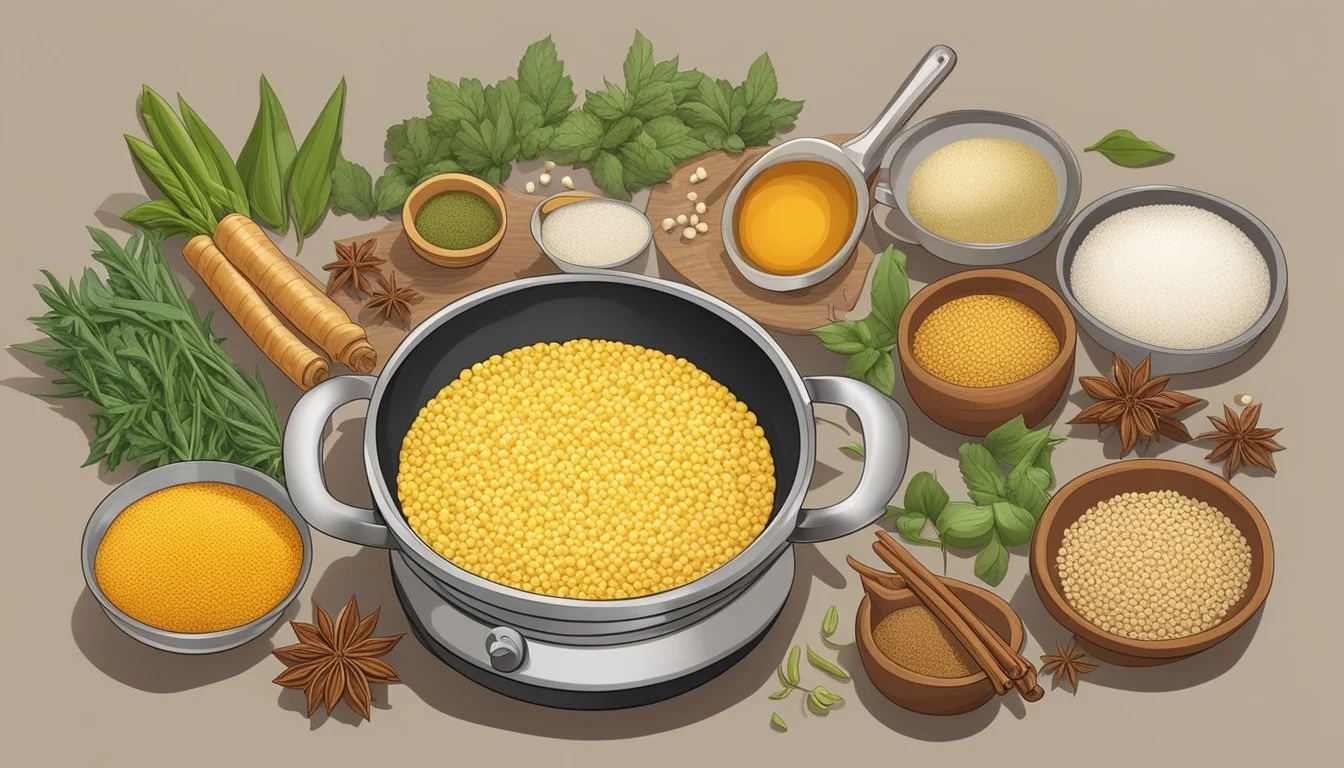Arhar Dal Substitutes
Best Alternatives for Your Recipes
Arhar dal, also known as toor dal or split pigeon peas, is a cornerstone of Indian cuisine, valued for its rich flavor and nutritional benefits. For those moments when you don't have arhar dal on hand or wish to try something different, there are excellent substitutes that can seamlessly fit into your dishes. Substitutes like moong dal, masoor dal, and chana dal offer similar textures and flavors, making them ideal replacements.
In various recipes, alternatives such as split peas, chickpeas, and mung beans can also provide comparable taste and nutritional value. For instance, moong dal, with its delicate flavor and quick cooking time, works well in place of arhar dal in dal fry or sambar. Similarly, lentils like masoor dal can bring their mild, earthy taste to soups and stews.
Experimenting with these substitutes not only ensures your dishes remain delicious but also helps diversify your culinary repertoire. From curries to soups, these legumes can enrich your meals with depth and variety, echoing the essence of traditional Indian delicacies.
Origins and Importance of Arhar Dal
Arhar Dal, also known as toor dal or yellow pigeon pea, holds a significant place in Indian cuisine. This legume has been a staple in Indian kitchens for centuries, particularly cherished for its ability to provide a complete protein when paired with rice.
Arhar Dal is extensively cultivated in India, especially in regions with warm climates. It is widely grown in Maharashtra, Uttar Pradesh, and Madhya Pradesh. The plant is resilient, thriving even in semi-arid conditions, making it a reliable crop for farmers.
In India, lentils like Arhar Dal are more than just food; they are intertwined with cultural and religious practices. They feature in various traditional dishes and are often used in rituals and festivals.
Nutritionally, Arhar Dal is a powerhouse. It offers approximately 8 grams of protein per 1/4 cup dry serving. Additionally, it contains essential nutrients such as iron, calcium, and folic acid. This makes it an excellent choice for vegetarian diets, providing necessary nutrients to maintain health.
Nutrient Amount per 1 Cup Calories 343 kcal Protein 8g Carbohydrates 63g Fiber 6g Iron 6% DV Calcium 2% DV
The importance of Arhar Dal in Indian cuisine is undeniable. It is used in numerous regional dishes, ranging from simple dals to complex curries. Its versatility and nutritional benefits make it a key ingredient in Indian households, appreciated across the country.
Nutritional Profile of Arhar Dal
Arhar dal, also known as toor dal, offers a rich nutritional profile, providing essential macronutrients and vital vitamins and minerals that support overall health. It is particularly noted for its high protein and fiber content.
Macronutrients in Arhar Dal
Arhar dal is an excellent source of protein, making it an important part of vegetarian and vegan diets. A typical serving of 1/4 cup dry toor dal contains approximately 8 grams of protein, which supports muscle maintenance and repair.
It is also rich in carbohydrates, with about 22 grams per serving, providing a steady source of energy.
Dietary fiber is another significant component of arhar dal, offering around 6 grams per serving. This aids in digestive health and helps maintain stable blood sugar levels.
The dal is relatively low in fat, with only 1.5 grams per serving, which makes it a good choice for those looking to manage their fat intake.
Finally, calories in arhar dal are moderate, with around 120 calories per 1/4 cup dry, making it conducive to weight management when consumed in controlled portions.
Vitamins and Minerals
Arhar dal is packed with several essential vitamins and minerals. It provides 2% of the daily value for calcium, which supports bone health, and 6% of the daily value for iron, crucial for oxygen transport in the blood.
It also contains a notable amount of magnesium, which is involved in over 300 biochemical reactions in the body, including energy production and muscle function.
Although less abundant, vitamin B complex such as thiamine and folate are present in arhar dal, playing an essential role in energy metabolism and red blood cell formation.
Common Uses of Arhar Dal in Indian Cooking
Arhar dal, also known as toor dal, is a staple ingredient in Indian cuisine. Its versatility allows it to be featured in various traditional dishes and makes it a key component in vegetarian diets.
Preparation in Traditional Dishes
Arhar dal is often used in popular Indian dishes like Dal Tadka and Dal Fry. Both involve cooking the dal with spices and then tempering it with heated ghee or oil, garlic, cumin seeds, and sometimes tomatoes.
For a richer taste, Dal Makhani includes cream and butter, providing a luscious texture. This dal variant is commonly served with naan or roti and is a favorite comfort food.
In South Indian cuisine, it is frequent in sambar, a tangy vegetable stew, and rasam, a spiced soup. These dishes highlight arhar dal's ability to blend with various spices and vegetables, enhancing both flavor and nutrition.
Role in Vegetarian Diets
Arhar dal is an essential protein source for vegetarians and vegans and is naturally gluten-free. It is often featured as a main dish in meals due to its nutritional value.
In meals, arhar dal is used alongside rice or roti, providing a balanced protein-rich diet. Its high protein content makes it an excellent meat substitute in vegetarian and vegan diets.
Cooked arhar dal is also used as a side dish, complementing vegetables and salads. Its creamy texture and mild flavor make it adaptable to different cooking styles and dietary requirements, making it a favorite among various regional cuisines across India.
Characteristics of Arhar Dal
Arhar Dal, also known as yellow lentils or split pigeon peas, is known for its distinctive visual, textural, and flavor characteristics. These aspects make it a staple in many Indian households.
Visual and Textural Properties
Arhar Dal is easily recognizable by its bright yellow color. It comes in the form of split lentils, which contributes to its unique texture. Once cooked, these lentils become soft and creamy, making them ideal for various savory dishes. The creamy texture paired with its ability to retain slight firmness provides a pleasant mouthfeel.
Flavor Profile
The flavor of Arhar Dal is often described as nutty and earthy. When cooked, it releases a soft and mild flavor that enhances dishes without overpowering other ingredients. The nutty and earthy notes make it versatile, working well with a wide array of spices and herbs commonly used in Indian cuisine.
Choosing Substitutes for Arhar Dal
Selecting the right replacement for Arhar dal involves understanding the functional and nutritional aspects of potential substitutes. Consider the dish's requirements and each alternative's texture and flavor profile.
Factors to Consider When Selecting Alternatives
Various factors should influence the choice of substitute for Arhar dal, also known as split pigeon peas. Texture and cooking time are critical, as they affect the final dish's consistency.
Nutritional content is also important. Many substitutes offer high protein and fiber, crucial for maintaining a balanced diet.
Availability at local grocery stores can simplify the selection process. Some ingredients are easier to find, reducing preparation time.
Popular Alternatives and Their Comparable Traits
Red Lentils and Masoor Dal are prominent choices due to their similar cooking times and texture to Arhar dal. They cook quickly and have a mild taste, making them versatile in various recipes.
Yellow Split Peas offer a close match in flavor and nutritional profile. They are high in protein and fiber, ideal for soups and stews.
Chana Dal (split chickpeas) provides a nutty flavor and firm texture, suitable for various Indian dishes.
Moong Dal and Urad Dal also serve as viable substitutes. Moong Dal has a softer texture when cooked, while Urad Dal offers a slightly denser consistency.
Choosing the right substitute involves balancing these traits to meet dietary needs and recipe requirements.
Cooking With Arhar Dal Substitutes
Using substitutes for arhar dal can be straightforward with the right adjustments to cooking techniques and seasonings. Key elements include recognizing the differing cooking times and methods, and tweaking spices to harmonize with the substitute ingredients.
Adjusting Cooking Techniques and Times
Cooking arhar dal substitutes like lentils, moong dal, or urad dal necessitates changes in cooking times and methods. Each type of legume has unique attributes affecting how they cook.
Lentils: Red lentils cook faster than arhar dal. They can be cooked on the stovetop or using an Instant Pot. Simmer them in water until soft, adjusting the water quantity to maintain the desired consistency.
Moong Dal: Yellow moong dal requires similar cooking times to arhar dal. It can be prepared using a pressure cooker, typically requiring 1-2 whistles. This method yields soft and creamy dal.
Urad Dal: Known for its thicker texture, urad dal might take a bit longer. Use a pressure cooker or stovetop, ensuring adequate water to prevent burning.
Tip: Always check the consistency and tenderness before adding additional ingredients or finishing the dish.
Adapting Seasonings and Spices to Substitutes
Every dal has a unique flavor profile, and substitutions mean spices need adjustment. Balancing spices like cumin, coriander, turmeric, and salt is crucial for maintaining the authentic taste.
Cumin and Coriander: These spices enhance any substitute's flavor. Toasting cumin seeds before adding other ingredients can add depth.
Turmeric and Red Chili Powder: Adjust these based on the substitute; moong dal, for example, is well-complemented by turmeric.
Hing (Asafoetida): This spice can be included early in the tempering process to enhance aroma.
Ghee and Oil: Using ghee for tempering with substitutes like lentils can add richness, combined with garlic for additional flavor.
Balancing these spices ensures a flavorful dish irrespective of the dal used.
Recipe Modifications Using Dal Substitutes
When you need to substitute arhar dal, consider how the new ingredient might affect the texture and flavor of your dish. Many alternatives can be used effectively in traditional Indian dishes like curries, soups, and as a side dish.
Semolina can be used as a replacement in dishes such as upma or idli. Its coarsely ground texture provides a unique and nutty flavor, making it a versatile substitute.
Toor dal is a direct alternative and can seamlessly replace arhar dal in preparations like dal fry or dal tadka. The similar texture ensures that the essence of the recipe remains intact.
Moong dal is another great substitute, especially for lighter dishes. It cooks faster and pairs well with rice, naan, or roti. Its mild flavor adapts easily to various spices and herbs used in different recipes.
Masoor dal, with its softer texture, can be used in both Indian curries and chapati accompaniments. Its quick cooking time makes it convenient for fast meals.
For a combination approach, try a mix of toor, moong, masoor, and sabut masoor dal. This blend offers a complex flavor profile and can be used in instant pot recipes or traditional methods.
Quick Guide to Substitutions
Traditional Recipe Substitute Notes Dal Fry Toor Dal Maintains similar texture Dal Tadka Moong Dal Quick cooking, mild flavor Upma Semolina Unique nutty flavor
These modifications ensure that you can enjoy your favorite dishes with readily available substitutes without compromising on taste or texture.
Incorporating Substitutes Into Indian Meals
Using substitutes for arhar dal in Indian meals can maintain nutritional balance and taste. Strategic pairing with staples and composing balanced plates ensures nutritional completeness.
Pairing with Staples
Substitutes like lentils, split yellow peas, and chickpeas can accompany staple foods such as rice and roti seamlessly.
For example, a combination of split yellow peas and steamed rice provides a simple yet nutritious meal. Masoor dal (red lentils) can be used in a dal tadka and paired with soft naan or chapati for an authentic Indian experience.
Papad and pickle add crunchy and tangy elements, respectively, enriching the flavor profile and textural variety of the meal. A well-chosen substitute should complement the staples in taste, texture, and nutritional value.
Creating Balanced Plates
Creating balanced plates with dal substitutes involves combining various food groups to ensure a comprehensive diet.
For instance, replacing arhar dal with moong dal (green gram) in a curry, accompanied by brown rice, a side of curried vegetables, and a crisp papad, creates a meal rich in protein, fiber, and essential vitamins.
Balancing proteins with whole grains such as millet or quinoa, and adding leafy greens or seasonal vegetables enhances the meal's nutritional profile. Including a small portion of pickle can also aid digestion.
Balancing both flavor and nutrition while incorporating substitutes will keep meals both delectable and healthful.
Culinary Tips for Optimal Use of Substitutes
To get the most out of substitutes for arhar dal, follow these tips:
Cooking: Always soak substitutes like split yellow peas or mung beans for a few hours beforehand. This reduces cooking time and ensures they cook evenly.
Tempering: Use a combination of ghee, butter, or oil for tempering. Heat the fat before adding mustard seeds, cumin seeds, green chili, and curry leaves. This enhances the flavor profile.
Aromatics: Incorporate ginger, garlic, and onions. Sauté until fragrant before adding the main dal substitute. This forms the base of many Indian dishes.
Tomato: Adding tomato will bring a slight tang and a rich color to the dish. Cook it until it's soft and blends with the aromatics.
Tadka: A final tadka can elevate the dish. Heat ghee or oil, add mustard seeds, and let them pop. Then add garlic slivers, dried red chili, and curry leaves.
Garnishing: Garnish with coriander leaves and a splash of lemon juice for freshness and acidity.
| Ingredient | Function |
|-----------------|-------------------------------|
| Ghee/Butter/Oil | Base for tempering |
| Mustard Seeds | Adds pungency |
| Curry Leaves | Adds aromatic flavor |
| Ginger, Garlic | Enhances depth of flavor |
| Onions | Forms the aromatic base |
| Tomato | Adds tanginess |
| Green Chili | Brings heat |
| Coriander Leaves| Freshens the dish |
| Lemon Juice | Adds acidity |Pay attention to the texture and flavor to mimic arhar dal closely. Adjust spices and seasoning based on preference.
Maintaining Nutritional Value With Substitutes
When finding substitutes for Arhar dal, ensuring nutritional value is key. Arhar dal is rich in protein, fiber, iron, and essential vitamins. Here are some alternatives that maintain similar nutrient profiles:
1. Lentils
Lentils are high in protein and dietary fiber. They also offer a good amount of iron and vitamins, making them a suitable replacement.
2. Split Chickpeas (Chana Dal)
Chana dal offers a significant amount of protein and dietary fiber, essential for a balanced diet. It also contains calcium and iron.
3. Yellow Split Peas
Yellow split peas are known for their high protein and fiber content. They also include essential minerals like iron and calcium.
4. Mung Beans
Mung beans are not only high in protein but also a good source of dietary fiber, vitamins, and minerals. They help in maintaining overall nutrient intake.
Nutrient Comparison Table
Substitute Protein (g) Fiber (g) Calories Iron (mg) Calcium (mg) Arhar Dal 7 5 110 3.4 34 Lentils 9 8 116 3.3 19 Chana Dal 10 8 120 2.8 60 Yellow Split Peas 8 9 115 2.5 20 Mung Beans 7 7 105 2.7 25
5. Black Beans
Black beans are another nutrient-dense option, high in protein, fiber, and essential minerals. They are particularly rich in iron and calcium.
Using these substitutes allows for maintaining a balanced nutritional profile without compromising on the essential nutrients provided by Arhar dal.










